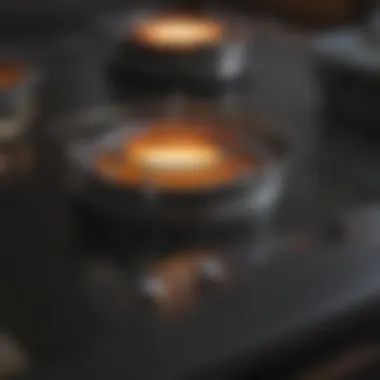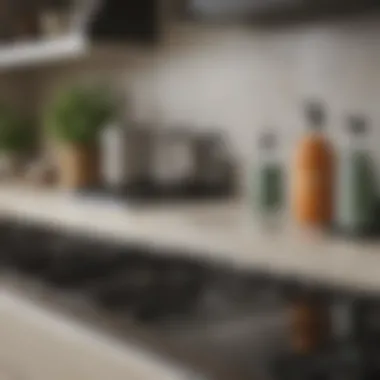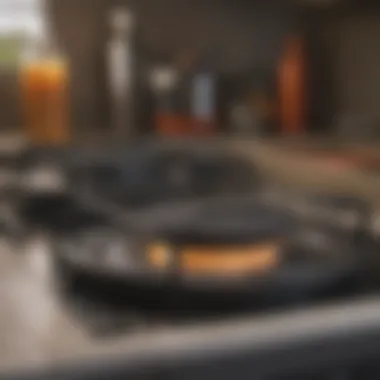Effective Methods for Cleaning a Smooth Top Stove


Intro
Keeping a smooth top stove clean is no simple task. Its sleek surface often attracts smudges, spills, and stubborn stains. A clear understanding of effective cleaning methods is essential for homeowners. Not only does regular maintenance enhance the aesthetic appeal, but it also prolongs the lifespan of the stove. This article will guide you through proven strategies specifically designed for smooth top stoves, emphasizing practical techniques and suitable products.
Key Insights and Trends
Understanding Smooth Top Stoves
A smooth top stove is popular in many modern kitchens, offering a blend of functionality and style. Making a choice to invest in such a stove means being aware of the care it requires. While the design enhances kitchen aesthetics, it also demands specific cleaning routines. Understanding the right techniques can make a significant difference in maintaining the stove’s pristine condition.
Environmental Concerns
In recent years, there has been a clear shift towards environmentally friendly cleaning agents. Homeowners are increasingly seeking solutions that are both effective and sustainable. This trend has led to the popularity of natural cleaning agents, such as baking soda or vinegar, which can effectively clean without harsh chemicals. Adopting these alternatives can benefit both your stove’s surface and the environment.
The Rise of Minimalism
The trend of minimalism in interior design also influences how homeowners care for their appliances. A simplified approach encourages regular maintenance to uphold a clean and uncluttered kitchen space. It aligns well with the notion of having fewer but better-quality household items, including kitchen appliances. This mindset can foster long-term care habits for smooth top stoves.
Practical Tips and How-To Guides
Routine Maintenance
- Daily Wiping: Use a soft cloth or sponge with warm, soapy water to wipe down the stove after each use. This quick habit prevents food buildup.
- Avoid Abrasives: Steer clear of abrasive pads or cleaners, as they can scratch the surface.
- Use Custom Cleaners: Investing in cleaners specifically designed for smooth top stoves can yield favorable results.
Tackling Stubborn Stains
If you encounter stubborn stains, consider the following steps:
- Baking Soda Paste: Mix baking soda with a small amount of water to create a paste. Apply it directly to the stain and let it sit for 10-15 minutes. Then, wipe it away with a damp cloth.
- Vinegar Solution: Spray a mixture of equal parts vinegar and water on tough spots. Let it sit before wiping.
"Regular maintenance is key. It is easier to clean a stove that is taken care of consistently."
Deep Cleaning Procedure
- Remove Cooktop Surface: If applicable, detach the cooktop for thorough cleaning. Check the manufacturer's guidelines.
- Gentle Scrubbing: Use a non-abrasive scrubber with a suitable cleaner to scrub stains gently.
- Rinse and Dry: Always rinse completely with clean water and dry the surface afterward to avoid streaks.
End
Prelude to Smooth Top Stoves
Smooth top stoves have gained popularity in modern kitchens for their sleek design and easy maintenance. These appliances not only enhance the aesthetic appeal of a kitchen but also provide exceptional functionality. Understanding the basic features of smooth top stoves is essential for homeowners who wish to maintain their efficiency and appearance.
Smooth top stoves usually consist of a glass surface that is heated by electric coils underneath. This design allows for quick and even heating, which is optimal for cooking a variety of foods. However, this surface can be prone to scratching and staining if not properly cared for.
The importance of knowing the features of a smooth top stove lies in how these characteristics influence cleaning methods. For instance, harsh scrubbers can damage the glass surface, emphasizing the need for gentle yet effective cleaning supplies. Additionally, the absence of traditional burners means that spills can spread across a larger surface area, making clean-up crucial for both functionality and safety.
Preventive measures, such as wiping spills immediately, can keep the stove in prime condition. A routine understanding of how the stove operates also aids in recognizing potential issues before they escalate. Thus, having a grasp of smooth top stove features sets the foundation for effective cleaning and long-lasting performance.
Understanding Smooth Top Stove Features
Smooth top stoves present several key features that impact their use and maintenance.
- Flat Surface: The flat cooking area promotes stability for pots and pans. This design also allows for easy cleaning since there are no crevices where food particles can become trapped.
- Temperature Control Settings: These stoves come equipped with precise temperature controls, making cooking more efficient. Understanding the control system helps in managing the stove effectively while avoiding overheating, which can lead to burnt food or damage.
- Visual Indicators: Many smooth top models display indicator lights to show when the surface is hot. This feature is essential for safety, as users can avoid burns when cleaning or touching the stove.
- Compatibility with Cookware: Not all cookware is suitable for smooth top stoves. Using pots and pans with flat bottoms is recommended to maximize contact with the surface, leading to better heating and minimizing scratching.
Understanding these features gives homeowners the foundation to make informed choices about cleaning techniques and products, ensuring the stove remains both functional and visually pleasing.


Importance of Regular Cleaning
Regular cleaning of a smooth top stove is not just a routine chore. It's a crucial aspect of appliance management that bears significant implications for functionality and appearance. By prioritizing clean lines and maintaining a pristine surface, homeowners can extend both the lifespan and utility of this kitchen centerpiece.
Preventing Damage and Wear
The smooth top stove, while stylish and effective, is susceptible to damage if not maintained properly. Food spills, grease, and residues can create a rough surface over time, leading to scratches that compromise its smoothness. These imperfections can affect the stove’s heating efficiency and mar its aesthetic appeal. Regular cleaning acts as a preventative measure against such wear.
When food debris is allowed to sit, it can harden and become difficult to remove. This not only makes cleaning more laborious but may also require stronger chemicals or tools, which can contribute to further damage. By establishing a consistent cleaning routine, you maintain the stove's surface, ensuring optimal cooking performance.
Maintaining Aesthetic Appeal
A smooth top stove represents modern design and functionality. Regular cleaning is essential to keeping this appliance looking new and attractive. Stains, smudges, or burnt residues can become eyesores that detract from an otherwise beautiful kitchen. The glossy finish tends to highlight imperfections if not cared for properly.
Homeowners should aim for practices that keep the surface gleaming. Clean stoves contribute to an overall tidy kitchen, enhancing the cooking space’s appeal. Furthermore, maintaining aesthetic attributes enhances the value of the home. When entertaining guests or preparing meals, a clean stove can boost confidence, reflecting attention to detail and care.
"A well-maintained stove not only functions well but also enriches the kitchen environment, making cooking a more pleasurable experience."
Essential Cleaning Supplies
Having the right cleaning supplies is critical for maintaining a smooth top stove. The efficacy of cleaning largely depends on the quality of the products and tools used. Investing in suitable supplies can save time and effort and also protect the stove's surface from potential damage. Here, we will explore essential elements that should be part of every homeowner's cleaning arsenal for their smooth top stove.
Recommended Cleaners
When selecting a cleaner for a smooth top stove, it is essential to choose products specifically formulated to tackle the delicate glass-ceramic surfaces. Some good options include:
- Cerama Bryte: This cleaner is well-known for its effectiveness on smooth top stoves and leaves no residue behind.
- Bar Keepers Friend: A versatile cleaner that works effectively on tough stains without scratching the surface.
- Cooktop Cleaning Creme by Weiman: This product is designed for regular use, providing a protective layer while cleaning.
Each of these cleaners is formulated to dissolve grime and prevent scratches, making them ideal for regular maintenance. When using cleaners, always follow the manufacturer's instructions for the best results.
Tools for Effective Cleaning
In addition to choosing the right cleaners, the tools used in the cleaning process greatly affect its success. A few essential tools include:
- Microfiber Cloths: Soft and non-abrasive, microfiber cloths effectively trap dirt and grease without scratching.
- Scraper: A plastic scraper can help remove burnt-on food without damaging the ceramic surface.
- Sponges with Soft Scrubbing Pads: These sponges can assist in lifting stains while being gentle on the surface.
Having these tools handy ensures efficient cleaning. It is crucial to avoid abrasive materials like steel wool, as they can cause irreparable harm to the smooth top stove.
"Using appropriate cleaning supplies not only maintains the appearance of your stove but also enhances its longevity."
With the right combination of cleaners and tools, cleaning a smooth top stove can transform from a mundane task into an efficient, easy process.
Step-by-Step Cleaning Process
The step-by-step cleaning process for a smooth top stove is pivotal to achieving effective results and maintaining the stove's surface integrity. Each phase is designed to address common residues and stains while ensuring the appliance remains in excellent condition. Following these organized steps not only improves cleaning efficiency but also prolongs the lifespan of the stove. It simplifies the task and reduces the risk of accidents related to improper cleaning methods.
Understanding each phase helps homeowners adopt a more methodical approach. By adhering to these steps, one can embrace both practical and aesthetic care for the stove, contributing to a safer cooking environment.
Preparation Before Cleaning
Before starting the actual cleaning, preparation is essential. Gather necessary tools and products to ensure a smooth process. This step eliminates interruptions and promotes efficiency. It's wise to wear gloves to protect skin from harsh cleaners. Clear the stove surface of all pots, pans, and any debris. Allow the surface to cool completely if used recently, to avoid burns. This sets the stage for an effective cleaning process and minimizes the risk of damage to the stove.
Initial Wiping for Residue Removal
After preparation, the initial wipe is crucial to remove loose dirt and debris. Use a soft cloth or sponge dampened with warm water to wipe the surface gently. This action helps remove food particles and prevents them from scratching the stove when scrubbing later. Avoid using abrasive materials, as they can harm the smooth surface. Focus on areas where spills and stains are visible. This step is simple but vital to ensure that further cleaning agents work effectively.


Applying the Cleaning Solution
Next, it is time to apply the cleaning solution. Choose a cleaner that is designed for smooth top stoves or make a DIY solution using vinegar and water. Spray the cleaner onto the stove surface evenly, allowing it to sit for a few minutes. This wait time enables the cleaner to break down tougher grime and grease, making them easier to remove. Do not apply the solution to a hot surface, as this can lead to burns and ineffective cleaning.
Scrubbing Techniques
When it comes to scrubbing, choosing the right technique matters. Use a non-abrasive pad or cloth for scrubbing. Apply gentle pressure and scrub in circular motions to lift stains. Focus on stubborn areas, but avoid harsh scrubbing, which can damage the cooktop. It's essential to rinse the cloth periodically to avoid reintroducing dirt during the process. The goal is to achieve a clean surface without damaging the underlying material.
Final Rinse and Drying
After scrubbing, a final rinse is imperative to remove any residual cleaner. Wipe the surface again with a clean, damp cloth to remove soapy residue. For drying, use a separate soft cloth or towel to avoid streaking. Drying not only improves the appearance of the stove but also prevents future dirt from adhering to the surface. This final step solidifies the cleaning effort, ensuring that the stove is ready for its next use.
"A clean stove improves cooking efficiency and adds to the overall kitchen aesthetic."
By following this structured cleaning process, homeowners can maintain their smooth top stove's pristine condition, enhancing both functionality and visual appeal.
Handling Stubborn Stains
Cleaning a smooth top stove is not just about regular maintenance; it often involves tackling stubborn stains that can diminish its appearance and performance. Understanding the specific challenges associated with these types of stains is key for any homeowner. Stubborn stains can arise from various cooking mishaps, leaving residues that resist simple cleaning methods. Addressing these effectively can prevent long-term damage to the stove surface, ensuring it remains in good condition for years to come.
Identifying the nature of the stains is the first step in handling them. Each type requires a tailored approach to ensure effective removal without causing harm to the stove surface. There are two main types of stains commonly found on smooth top stoves: burnt-on food residues and hard water spots. Both necessitate different cleaning techniques and tools.
Common Types of Stains
- Burnt-on food residues are often the result of spills or food that has adhered to the stove surface during cooking. These may include grease, sauces, or melted foods that have hardened and require diligent attention.
- Hard water spots form when mineral deposits settle on the stove’s surface, typically from water used during cooking. These stains can appear as cloudy spots and are not always easy to remove.
Recognizing these stains is crucial. The nature of the stain directly impacts the method of cleaning that should be employed. Understanding these common stains allows the homeowner to prepare adequately and select the right cleaning solutions.
Effective Removal Techniques
To effectively remove stubborn stains from a smooth top stove, consider the following techniques:
- For burnt-on food residues:
- For hard water spots:
- Begin by applying a specialized stove cleaner directly to the stained area. Products like Cerama Bryte or Weiman are formulated for this purpose and can effectively loosen residues.
- After applying, allow the cleaner to penetrate for a few minutes. This will assist in the removal process.
- Use a non-abrasive scrub pad to gently scrub the area. It is important to avoid steel wool or any abrasive material that might scratch the surface.
- Wipe with a damp cloth to remove the cleaner and any loosened residue.
- Create a paste using baking soda and water. Apply this paste to the affected areas. Baking soda acts as a mild abrasive that can lift these spots without damaging the surface.
- Leave the paste on for around 10 to 15 minutes; this will help it break down the mineral deposits.
- Wipe off with a wet sponge, and ensure to rinse thoroughly to remove any baking soda residue.
These techniques, when combined with the right cleaning supplies, can lead to effective results. Remember, treating stains promptly is paramount in preventing them from becoming more entrenched over time.
Important: Always test any cleaner on a small, inconspicuous area first to ensure compatibility with the smooth top stove surface.
Environmentally Friendly Cleaning Options
In the current age, choosing environmentally friendly cleaning products is more than just a trend; it is a necessity. Many homeowners are increasingly aware of the impact that traditional cleaning agents can have on both health and the environment. This section delves into the significance of using eco-friendly solutions when cleaning smooth top stoves. Not only do these options minimize harmful chemical usage, but they also contribute to a sustainable lifestyle.
Choosing environmentally friendly cleaning options often results in better indoor air quality. Traditional cleaners may release volatile organic compounds (VOCs) that can cause respiratory issues, especially in poorly ventilated spaces. On the other hand, natural or biodegradable products ensure that harmful agents do not linger in your home. Additionally, they are typically gentler on the surface of your stove, reducing the risk of scratches and other damage.
Moreover, environmentally friendly cleaners can be cost-effective. Many of these products can be made from common household items, which means you do not have to continually purchase specialized cleaners. This not only saves money but also reduces waste, making it a smart choice for eco-conscious consumers.
Natural Cleaning Solutions
Natural cleaning solutions provide an effective way to keep your smooth top stove clean without relying on harsh chemicals. Many ingredients that exist within your home can provide remarkable cleaning ability while remaining safe for the environment.
Common natural cleaning agents:


- Vinegar: A powerful disinfectant, vinegar can cut through grease and grime effectively. Its acidity helps to dissolve tough stains.
- Baking Soda: This gentle abrasive is ideal for scrubbing without scratching the surface. It can also neutralize odors effectively.
- Lemon Juice: The citric acid in lemon juice not only helps to clean but also leaves behind a fresh scent. It can help in cutting through tougher stains with ease.
These ingredients can be mixed to create powerful cleaning pastes or sprays. When using natural cleaners, it is essential to let them sit for a while on stubborn stains to ensure effective cleaning. This allows the ingredients to penetrate the grime and break down tough residue.
DIY Cleaning Recipes
Creating your own eco-friendly cleaning solutions can be both simple and enjoyable. Below are a couple of straightforward recipes that homeowners can apply for effective stove cleaning.
- Vinegar and Baking Soda Paste
- Lemon and Vinegar Spray
- Mix equal parts of baking soda and water to create a thick paste.
- Add a few tablespoons of vinegar to the mixture. It will froth up and become a powerful cleaning agent.
- Apply the paste to the stove, let it sit for 15 minutes, then scrub gently with a soft cloth or sponge. Rinse with water afterward.
- Combine the juice of one lemon with one cup of vinegar.
- Pour the mixture into a spray bottle and shake well.
- Spray the solution directly onto the stove, let it sit for a few minutes, and then wipe clean. This will cut through grease and leave the surface gleaming.
Employing these DIY cleaning solutions provides a safe way to maintain your smooth top stove while preserving the environment. Opting for natural methods not only benefits your cooking space but contributes to a healthier planet as well.
Preventing Future Stains and Damage
Preventing stains and damage on a smooth top stove is vital for its longevity and appearance. Often considered the centerpiece of modern kitchens, these stoves can lose their shine if not cared for properly. Understanding the habits that contribute to wear is the first step toward maintaining a pristine cooking surface.
There are numerous benefits to avoiding future stains. For one, it reduces the need for recurring, intensive cleanings. Additionally, keeping the surface intact prolongs the life of the appliance, saving homeowners replacement costs. Also, a well-maintained stove enhances the overall aesthetic of the kitchen, providing a welcoming environment for cooking and entertaining.
A few specific practices can help in this regard. The benefits can be substantial when they are incorporated into daily routines. It may take conscious effort to avoid certain actions but is worth it in the long run.
Cooking Practices to Avoid
To effectively control the condition of the smooth top stove, there are cooking practices that should be minimized or avoided altogether:
- Avoid Boiling Over: When pots boil over, food particles can harden on the surface. This can lead to stubborn stains. Monitor cooking pots closely to prevent this situation.
- Use Flat-Bottomed Cookware: Opt for cookware with flat bottoms. Uneven pans can scrape the stove's surface, causing scratches that are difficult to repair.
- Do Not Slide Cookware: Lifting rather than sliding pots reduces the chance of scratching the glass. Sliding generates friction that can mar the surface's finish.
- Avoid High Heat Settings for Extended Periods: Consistent high settings can cause the glass to warp or develop cloudiness. Cooking at moderate temperatures whenever possible is advisable.
By making these adjustments, homeowners can significantly improve the longevity of their smooth top stoves and keep them looking new.
Regular Maintenance Tips
Consistent maintenance is essential to avoid future stains and damage. Here are several practical tips:
- Wipe After Use: After each use, even with a simple microfiber cloth, wiping down the stove prevents residue build-up. Clean spills immediately for best results.
- Use Protective Covers: Consider using stove covers or glass top protectors when the stove is not in use. This simple act limits exposure to dust and other debris that can lead to scratches.
- Regular Deep Cleaning: Plan for thorough cleanings on a weekly basis. Utilizing proper cleaning agents can help maintain the stove’s luster and counteract any potential damage.
- Educate Family Members: Ensure that everyone using the stove is aware of proper cooking habits. This ensures the integrity of the appliance is maintained across cooking experiences.
By implementing these practices, your smooth top stove will remain in excellent condition, making cooking a more enjoyable and efficient experience.
End
Maintaining a smooth top stove is not merely a matter of aesthetics; it carries practical significance for long-term performance. In this article, we discussed various cleaning methods, focusing on both routine care and strategies to combat stubborn stains. Regular cleaning prevents potential damage, ensuring that the surface remains functional and visually appealing.
Recap of Key Methods
To effectively clean a smooth top stove, several key methods were highlighted:
- Regular Cleaning Routine: Wipe the stove after each use to prevent residue build-up.
- Use Appropriate Cleaners: Choosing cleaners specifically designed for smooth tops can make a significant difference in effectiveness.
- Gentle Scrubbing Techniques: Employing non-abrasive pads helps in lifting stains without scratching the surface.
- Tackling Stubborn Stains: Certain solutions, such as baking soda mixtures or vinegar, can help remove tough marks without damaging the surface.
These methods, when combined, create a comprehensive approach to stove care, maximizing both cleanliness and durability.
Encouragement for Efficient Care
Ongoing attention to the condition of your smooth top stove reaps many rewards. Regular upkeep not only preserves the shine and finish but also enhances the overall cooking experience. *Prioritize the use of eco-friendly cleaners whenever possible.* This not only contributes to a healthier kitchen environment but also aligns with sustainable principles.
Invest time into these cleaning practices. The consistency will lead to significant improvements in the lifespan of the stove and provide a safer cooking surface. Efficiency in cleaning facilitates a broader joy in cooking and entertaining, making it worthwhile to adopt these habits.
"An ounce of prevention is worth a pound of cure."
By incorporating these strategies recommended in this article, homeowners can achieve an optimal state of cleanliness and functionality for their smooth top stoves, ultimately enhancing both efficiency and the enjoyment of the kitchen.



